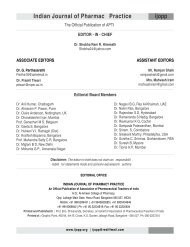Jul-Sep, 2012 - Indian Journal of Pharmacy Practice
Jul-Sep, 2012 - Indian Journal of Pharmacy Practice
Jul-Sep, 2012 - Indian Journal of Pharmacy Practice
You also want an ePaper? Increase the reach of your titles
YUMPU automatically turns print PDFs into web optimized ePapers that Google loves.
<strong>Indian</strong> <strong>Journal</strong> <strong>of</strong> <strong>Pharmacy</strong> <strong>Practice</strong>Association <strong>of</strong> Pharmaceutical Teachers <strong>of</strong> IndiaDrug Induced Syndromes: An Overview1 2 3 4Mahendra Kumar BJ , Soumya M , Jyothi K and Jagadish B. D*1Director PG Studies, Pr<strong>of</strong>. & Head, Department <strong>of</strong> <strong>Pharmacy</strong> <strong>Practice</strong>, JDT Islam College <strong>of</strong> <strong>Pharmacy</strong>, Jamiath Hill, Kozhikode, Kerala.2Lecturer, Department <strong>of</strong> Clinical <strong>Pharmacy</strong>, SAC College <strong>of</strong> <strong>Pharmacy</strong>, BG Nagara, Karnataka3,4Pharm D Students, Department <strong>of</strong> Clinical pharmacy, SAC College <strong>of</strong> pharmacy, KarnatakaA B S T R A C TSubmitted: 04/07/<strong>2012</strong>Accepted: 12/08/ <strong>2012</strong>Many drugs have come into the market in recent years and its usage is increased for multiple disorders which in turn leads to poly pharmacy andincreased drug related problems. One such drug related problem is Drug-induced syndrome. These syndromes are one <strong>of</strong> the major problems inthe health care sector. Drug related problems are found to be a reason for hospital admission and also for an increased patients stay in thehospital. The syndromes can be associated with any pathological conditions or may be drug related. This overview article provides theinformation regarding the different drug induced syndromes with its causative agents, clinical manifestation and therapy.Keywords: Drug induced syndrome, drug related problem,INTRODUCTIONThe word "Syndrome" derived from the Greek wordsundrom, which means concurrence <strong>of</strong> symptoms, or fromword sundromos, which means running together. Syndromeis a set <strong>of</strong> symptoms occurring together. In medical contextsyndromes are classified as syndromes caused due toenvironmental causes, cardiovascular, iatrogenic, neoplastic,congenital, endocrine, pulmonary, infectious, renal,neurological, gastrointestinal, reticulo-endothelial,1hematologic, others.Drug-induced syndromes or iatrogenic (physician induced)syndromes are produced by drugs themselves and leads tocertain pathological changes. These are temporally relatedwith starting a drug, and the symptoms and signs generally2, 3regress with its discontinuation. The increasing number andcomplexity <strong>of</strong> diagnostic procedures and therapeutic agents,monitoring <strong>of</strong> untoward events is essential, and attentionshould be paid to educational efforts to reduce the risks <strong>of</strong>4iatrogenic illness. Important risk factors for adverse drugevents or reactions included polypharmacy, drugs withnarrow therapeutic range, renal elimination <strong>of</strong> drugs, age >65years and use <strong>of</strong> anticoagulants or diuretics. Since medicationerrors are strong risk factors for preventable adverse drugevents or reactions, strategies have to be put in place for theirreduction. Such strategies include ensuring that all personsinvolved in the medication process (nurses, pharmacists andAddress for Correspondence:Dr. BJ Mahendra Kumar, Director PG Studies, Pr<strong>of</strong>. & Head, Department <strong>of</strong><strong>Pharmacy</strong> <strong>Practice</strong>, JDT Islam College <strong>of</strong> <strong>Pharmacy</strong>, Jamiath Hill, Kozhikode,Kerala.Email address:bjmahendra2003@yahoo.co.inphysicians) have good pharmacological knowledge,computerization <strong>of</strong> the entire medication process, and theengagement <strong>of</strong> a sufficient number <strong>of</strong> clinical pharmacists on5the wards.The drugs with single or combination can leads to iatrogenicsyndromes with severity ranging from mild to severe.Awareness should bring towards health care pr<strong>of</strong>essionals forthe management <strong>of</strong> drug induced syndromes. This articlebrings brief description <strong>of</strong> drug induced syndromes includingcausative agents, symptoms and management.Drug Rash with Eosinophilia and Systemic symptomsSyndrome (DRESS): DRESS syndrome reflects a serioushypersensitivity reaction to drugs and has been classifiedunder a delayed type IVb hypersensitivity reaction, where T6helper type II cells play a significant role. (Fig 1)Causative drugs: Anticonvulsants, Sulfonamides, Dapsone,Allopurinol, Minocycline, Gold, Hydroxychloroquine(HXQ) Sulfate, Isoniazid, Rifampicin, Ethambutol and6, 7Pyrazinamide.Symptoms: Fever is usually present. Skin eruption may varyfrom a diffuse maculopapular inflammatory rash toerythroderma, Stevens–Johnson syndrome or erythemamultiform. Concerning organ involvement, lymph nodes,liver and kidney are frequently affected; lung and heart are6involved in a minority <strong>of</strong> the cases.Treatment: Causative drugs should be withdrawn as a part <strong>of</strong>the treatment and steroids are useful for patients with lifethreateningvisceral manifestations such as interstitialPneumonitis or nephritis. In milder cases, topical steroidsimprove the skin manifestations. Interferon-α is also useful6, 7for long-lasting DRESS.<strong>Indian</strong> <strong>Journal</strong> <strong>of</strong> <strong>Pharmacy</strong> <strong>Practice</strong> Volume 5 Issue 3 <strong>Jul</strong> - <strong>Sep</strong>, <strong>2012</strong> 13
















